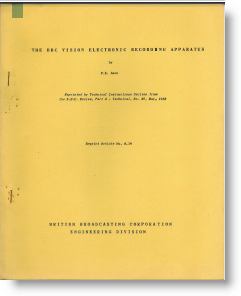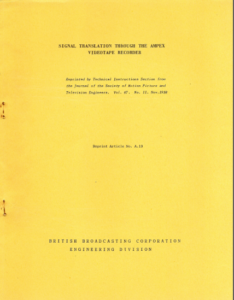The problem of recording television signals on magnetic tape has been the
subject of investigation for many years.
This set of reprints describe the design of videotape recording equipment. There were two initiatives running contemporaneously.
The main issue with videotape was to get a high enough speed of the recording recording medium past the recording head to cope with the bandwidth required – the higher the speed, the greater the bandwidth. The BBC Research and Design Departments were looking at using standard sound recording tape running at a high speed, whereas Ampex were investigating the use of wide tape with transverse recording – spinning the recording and replay heads.
| | These papers constitute the first technical discussions of the Ampex video tape recording system, presented on 11th October 1956 at the Society of Motion Picture and Television Engineers Convention at Los Angeles.
Various problems encountered in the development of the recorder are discussed and the steps taken toward solutions are described in detail.
| Source: | The Journal of the Society of Motion Picture and Television Engineers. Volume 66. Number 4. | |
| Date: | April 1957 |
|
| | This article deals with a new system of recording television on magnetic tape, the first to be developed in Europe. The system is remarkable not only for its novelty, but also for its originality. In contrast with the American systems, which use very wide magnetic tapes, recorded transversally and tape transport running at the speed used for sound recording, the B.B.C. equipment uses tape of more normal dimensions, recorded longitudinally, but running at a considerablv higher speed. It will be most interesting to compare the performance of the two systems when they are in operational use by broadcasting organisations, which will in the next few years almost certainly record more and more television programmes on magnetic tape.
| Source: | The E.B.U. Review, Part A – Technical, No. 49 | | Date: | May 1958 |
|
| | The various operations performed on the video signal as it travels through the Ampex Videotape Recorder are fully described. Also included is a brief description of the history of each problem encountered, and some of the reasons for the solution applied.
| Source: | The Journal of the Society of Motion Picture and Television Engineers. Vol. 67. No. 11. | | Date: | November 1958 |
|
Back to top
Back to reprint index







